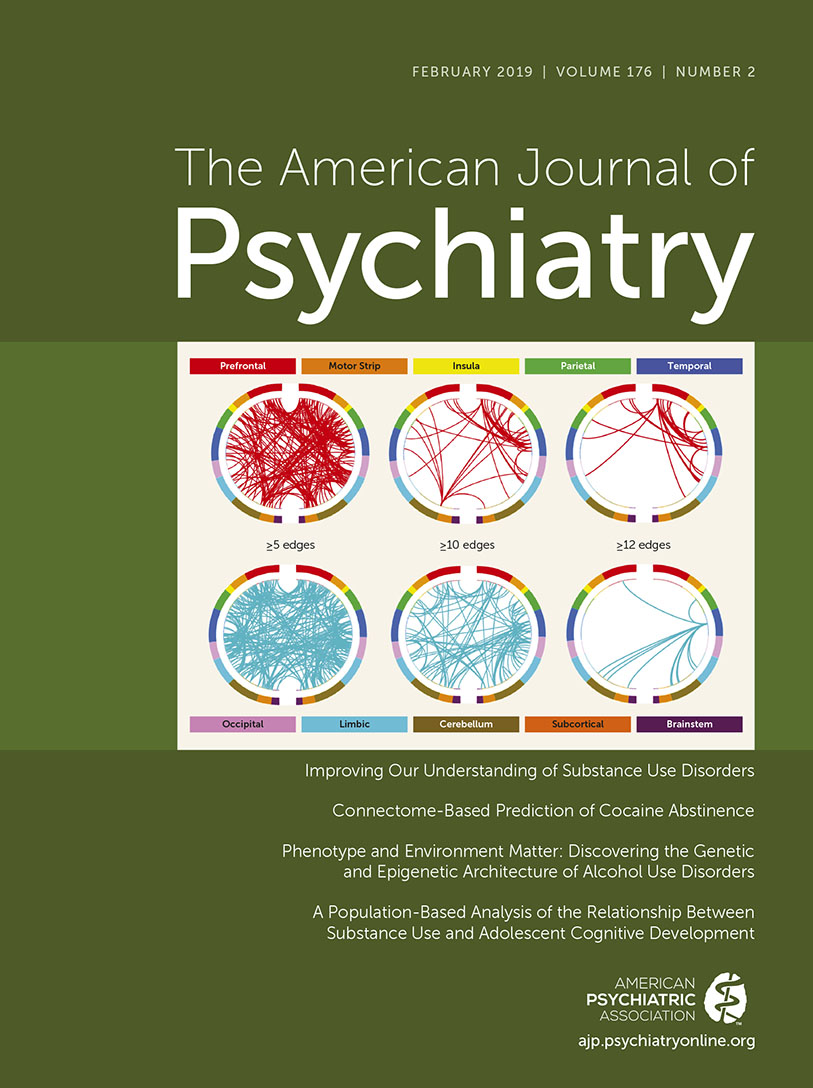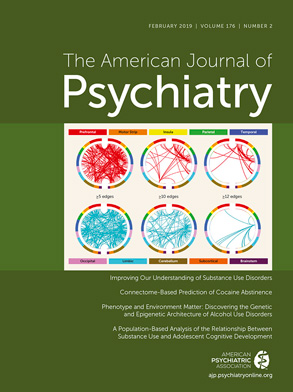Societal attitudes toward cannabis use are changing rapidly. In the past decade, there has been a wide-ranging movement toward removal of criminal sanctions on cannabis use, and in some localities cannabis use is permitted in a regulated manner, similar to alcohol. This movement has raised some concerns about whether we understand the full implications of cannabis use, particularly in younger individuals. Although cannabis is clearly associated with fewer fatal consequences than alcohol use, it has long been understood that cannabis use can be associated with persistent and substantial cognitive changes (
1) and possibly alterations in motivational processes (
2).
The most recent large-scale legalization of cannabis use has occurred in Canada. Effective October 17, 2018, Canada removed all criminal sanctions on marijuana use, in a move characterized by Prime Minister Justin Trudeau as improving the safety of the population by removing the influence of organized crime on the distribution of marijuana (
3). With cannabis use legal in nine U.S. states and the District of Columbia, this means that over 200 million residents of the United States and 37 million Canadians have legal access to recreational cannabis.
In that context, the article by Morin et al. in this issue (
4) is particularly timely. The authors studied the longitudinal changes in cognitive performance associated with cannabis use in 3,826 students in Montreal who were examined annually over a 4-year period. The strengths of the study include annual assessments with cognitive tests, a starting time in seventh grade, which captures a critical period for both brain development and substance use, and a comparison of cannabis effects with the effects of alcohol. Cognitive performance was examined with performance-based assessments that have known validity and standardization for this age group. Analyses compare both the between-subject differences associated with types and levels of substance use and, more interestingly, the within-subject effects of substance use on cognitive performance. The latter analysis can actually pinpoint year-by-year within-individual changes associated with substance use.
The authors discovered several interesting things. First, all elements of both alcohol and cannabis use increase annually across the various levels of frequency of use, with the exception of daily alcohol use. Second, the effects of cannabis are considerably greater than those of alcohol. Third, there appear to be both concurrent and lagged effects of cannabis use on several cognitive domains. Thus, use of cannabis has persistent effects that are also exacerbated by continued use.
In this study, the authors could not estimate actual dosing of cannabis in the same way that they could for alcohol. Also, the proportion of alcohol users who would be considered possible binge drinkers was 20% or less, so drinking was more common than cannabis use, but the number of participants with very high doses of alcohol was limited. This is probably due to the young age of the sample and the relative difficulty of gaining access to high doses of alcohol at that age.
Although the effects on cognitive performance associated with cannabis use do not block maturation-associated improvements in performance on the tasks across all domains, they are substantial in some areas. For example, in relation to inhibitory control, tenth graders who have concurrent use and past-year use of cannabis perform like seventh graders who have never used cannabis. This is a 4-year disadvantage. Performance on measures of inhibitory control also shows a between-subject effect, in that all of the cannabis user groups make about 25% more errors at the grade 7 baseline assessment than those participants who never showed signs of developing cannabis use over the 4-year period.
What is concerning about these data is that this deficit in inhibitory control shows an early, persistent, and dose-dependent association with cannabis use in a very early age group with relatively infrequent use. As these children grow older, it is very likely that their opportunities for cannabis use will increase with naturally occurring decreases in parental supervision. Interacting with these anticipated reductions in supervision is the widely expected increased access to cannabis that will occur with legalization.
Extrapolating forward, it might be expected that additional cognitive changes would accrue with sustained cannabis use. Meier et al. (
1) previously presented results from the Dunedin study of adult consequences of adolescent-onset cannabis use. There are several parallels to the present study. In the Dunedin study, onset of cannabis use was examined in an age period similar to that of the Morin et al. study (ages 7–13). Participants were reassessed at ages 18, 21, 26, 32, and 38, and a wide-ranging cognitive assessment battery was administered at the age-38 assessment. As in the Morin et al. study, other drug use was adjusted in the models and cannabis use was defined both in terms of meeting criteria for cannabis dependence at the successive follow-up intervals and in terms of regular use during those periods. In addition to the performance-based assessment, informant reports were collected. No baseline differences in intelligence between the different use groups were detected; in fact, the baseline IQ of those who never used cannabis in the entire follow-up period and those with persistent abuse at age 38 were identical (99.84 and 99.68, respectively).
The cognitive effects of persistent cannabis use were substantial in the Meier et al. study (
1). Both regular use and a persistent diagnosis of cannabis dependence were associated with 6-point within-subject declines in total IQ. These effects were similarly present in users who did and did not pursue postsecondary education. Of the comprehensive assessments, the WAIS processing speed index was most affected, with an effect size difference (Cohen’s d) of 0.75 between groups at age 38. The largest single difference assessed was in the ability to recite the months of the year in reverse order, with an effect size of 0.87 between groups. Informant reports of cognitive limitations were substantial as well, with an effect size of 1.17 for attentional impairments and 1.02 for memory problems. In contrast to recent research on smoking cessation and cognition (
5), reducing cannabis use did not lead to restoration of cognitive functioning.
Thus, the Morin et al. study suggests that cannabis-related cognitive changes are detectable and important during the middle school and high school years, and the Meier et al. study shows that persistent cannabis use leads to major cognitive challenges up through the late 30s. Both studies concluded that the effects of cannabis were neurotoxic and led to within-subject adverse effects starting in preadolescence and early adolescence that were larger than between-subject effects.
Thus, there are signs of early-onset and persistent effects of cannabis use on cognition in quite different but very comprehensive studies. If that were the only potential effect of early-onset cannabis use, there would be considerable reason for concern. However, there is a whole other research theme on early-onset cannabis use that is worth mentioning: increased risk for development of psychosis. This area has been investigated in detail, and the results of meta-analyses of epidemiological data (
6) have suggested that the risk for schizophrenia among cannabis users is about double the population base rate, at around 2%. The risk could also be increased within individuals by genomic or life-stress-related factors. Although these data suggest that 98% of cannabis users are probably not at risk for schizophrenia, a doubling of risk for any lifelong serious mental illness is clearly a cause for concern.
The results of the Morin et al. study combine with previous research on the neurocognitive and neuropsychiatric effects of cannabis to suggest a need for considerable concern and possible surveillance of the impact of the anticipated wider access to cannabis associated with legalization. Although individuals in the age range of those in the Morin et al. study will not have legal access to cannabis, it would be naive to think that the general increase in access to cannabis will not trickle down to those who are under the legal age of use. As the adverse cognitive effects of early-onset cannabis use appear to be clear, education and prevention efforts will be needed to prevent academic and other consequences of cannabis use early in life.

